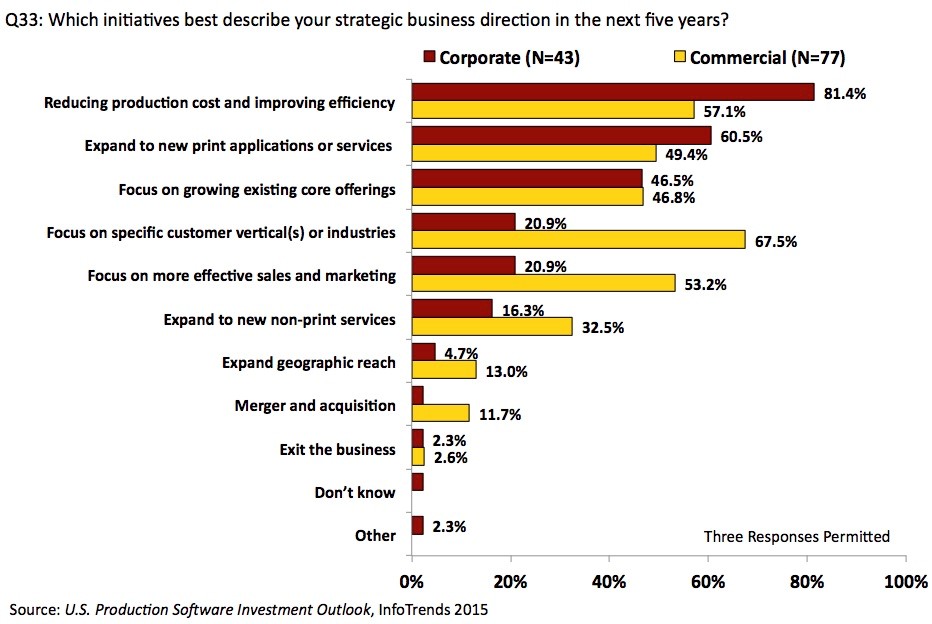As mentioned in a previous blog, in a recent InfoTrends study entitled U.S. Production Software Investment Survey 2015, commercial print service providers and corporate in-plants were surveyed about their software usage and purchase intentions, services offered, and as we will discuss, their strategic business direction. When the 120 responses were separated into corporate in-plant printers and commercial printers, some interesting differences appeared.
The top-three answers from the corporate in-plant printers were reducing production cost and improving efficiency, expanding to new print or services, and focusing on growing their existing core offerings. While commercial printers also listed reducing production cost and improving efficiency in their top three, they also reported focusing on more specific customer vertical markets or industries and focusing on more effective sales and marketing.

Many of these results are not new but they continue to gain greater momentum and grow in significance. For example, the desire to reduce manufacturing costs continues to be a top priority for all types of companies due to competitive pricing. It doesn’t matter if you’re an in-plant competing with the outsourcers or a commercial printer competing with online service providers…the motivation to reduce manufacturing costs and offer more competitive products remains a critical success factor. In addition, as print volumes continue to decline, offering new print application and services continues to grow in importance.
The increased focus for commercial printers on specific vertical markets and industries is, in our opinion, long-overdue. Barb Pellow, the Group Director at InfoTrends has been preaching this in presentations and webinars for years. In the book, “The Winning Performance: How America’s high-growth Midsize companies succeed” authors D.K. Clifford Jr. and R.E. Cavanaugh say, “Midsize high-growth companies succeed by identifying and meeting the needs of certain kinds of customers – not all customers – for specific kinds of products and services. Business academics call this market segmentation, entrepreneurs call it common sense.”
One of the challenges for in-plant printers is the fact that they’re often discouraged in hiring sales staff. A lack of sales efforts can exacerbate the normal decline in volume by existing customers and make the impact of customer churn more devastating. According to churn-rate.com, churn rate is the amount of customers or subscribers to cut ties with your service or company during a given period. Most business experts believe that customer churn is inevitable. Without a mechanism to acquire new customers, companies must add new products and services in an attempt to maintain sales volumes.
Many in-plant printers understand the importance of sales and marketing and find creative ways to pursue those efforts. Some use “Open Houses,” others use “New staff orientation programs.” In addition, those responsibilities are often added to in-plant managers or customer service staff.
For any in-plant who listed “Focus on more effective sales and marketing” as a low priority, remember it doesn’t really matter what you call it or who does it, in-plants have to focus more time and attention on sales efforts.



